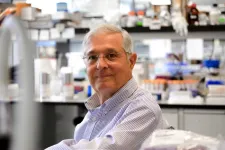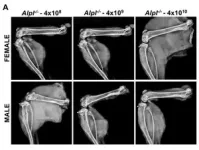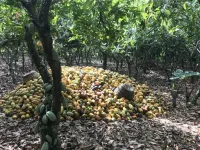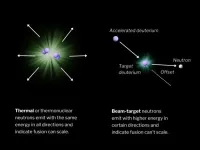(Press-News.org) For the last 10 years, the only effective treatment for hypophosphatasia (HPP) has been an enzyme replacement therapy that must be delivered by injection three-to-six times each week.
“It's been a tremendous success and has proven to be a lifesaving treatment,” said José Luis Millán, PhD, professor in the Human Genetics Program at Sanford Burnham Prebys. “Many children who have been treated otherwise would have died shortly after birth, and they are now able to look forward to long lives.
“It is, however, a very invasive treatment. Some patients have reactions from frequent injections and discontinue treatment. That has motivated us to find the next step in treating this disease.”
HPP — also known as soft bone disease — is a rare inherited disorder that causes abnormal development of bones and premature loss of teeth. HPP ranges in severity. Milder cases put affected adults at greater risk of breaking bones. Severe forms of the condition cause life-threatening disease in approximately one per 100,000 live births.
Currently, patients are treated with injections of asfotase alfa, a mineral-targeted form of the missing enzyme called tissue-nonspecific alkaline phosphatase (TNAP). This FDA-approved therapy is based on Millán’s decades of research on the TNAP enzyme and his laboratory’s studies demonstrating preclinical safety and efficacy.
“We believe the next evolution in treating HPP will be a gene therapy in which a single injected dose will provide a lifelong treatment for patients,” said Millán.
In a paper published January 12, 2025, in the Journal of Bone and Mineral Research, Millán’s team and collaborators added additional weight to prior preclinical evidence of the safety and effectiveness of a gene therapy for HPP.
The new study focused on AAV8-TNAP-D10, a virus engineered to not cause disease but rather to deliver a gene capable of producing the missing TNAP enzyme and reversing the malformation of bones and teeth. While previous research in the Millán lab had demonstrated the safety and effectiveness of this approach, the new investigation is intended to inform future clinical trials by including different dosages of the gene therapy, tests in male and female mice, and examinations in early- and late-onset forms of HPP.
“We have essentially titrated the viral vector to show which dose achieves efficacy without causing side effects such as accumulations of bony crystals in soft organs called ectopic calcifications,” said Millán. “Our data provide a clear starting point for clinical trials.”
The research team also noted one unexpected finding. In mice modeled to develop late-onset HPP as adults rather than infants, the gene therapy was more effective on female mice, and in females the improvements in bone and teeth were achieved with a lower dose of the treatment.
The scientists then compared the location of new enzymatic activity spurred by the gene therapy. In adult female mice with late-onset HPP, the greatest amount of activity occurred in the limb muscle, the site of injection of the viral vector. In males, however, the most activity was found in the liver.
“When I presented the data regarding this sexual dimorphism at the American Society for Bone and Mineral Research in Toronto last year, several physicians shared that this phenomenon is known in mice but does not happen in non-human primates or humans,” said Millán. “We don’t anticipate seeing this in future clinical trials, but now those monitoring the trials will be aware of the possibility.”
With ample preclinical research now established in the scientific literature, the next step is for Millán and his longtime collaborators — Drs. Takashi Shimada and Koichi Miyake of Nippon Medical School in Japan — to engage with a company capable of advancing AAV8-TNAP-D10 into clinical trials. Millán also is focused on future research to understand long-term complications that patients with HPP may face in the next few decades.
“We have patients now that will have long lives thanks to enzyme replacement and future therapies, but we’re only able to fix the skeletal mineralization. We know the missing enzyme also is expressed in the brain, the liver, the kidney, the immune system and elsewhere.
“That is what occupies my mind right now. We need to anticipate long-term problems before they happen so we can be prepared to help patients with HPP throughout their lives.”
Additional authors on the study include:
Flavia Amadeu de Oliveira, Cintia Kazuko Tokuhara and Sonoko Narisawa from Sanford Burnham Prebys
Fatma F. Mohamed, Elis J. Lira dos Santos, Natalie L. Andras and Brian L. Foster from The Ohio State University
Mohammad Shadid from Korro Bio
Koichi Miyake from Nippon Medical School
The study was supported by the National Institutes of Health (R01 DE12889, R21 DE031889, AG0811167, R01 DE032334), Aruvant Pharmaceuticals and the Endocrine Fellows Foundation.
The study’s DOI is 10.1093/jbmr/zjaf005.
The Journal of Bone and Mineral Research published a commentary on this study on February 2, 2025, titled, “Novel therapeutic options for hypophosphatasia.” Wolfgang Högler, MD, chair of Pediatrics at Johannes Kepler University in Austria, and Lothar Seefried, MD, head of the department of Osteology and clinical research at Julius-Maximilians University Würzburg in Germany, authored the article.
END
Gene therapy may be “one shot stop” for rare bone disease
New study adds to evidence that a single shot may be effective against a skeletal disease that currently requires nearly daily injections to treat
2025-02-03
ELSE PRESS RELEASES FROM THIS DATE:
Protection for small-scale producers and the environment?
2025-02-03
Sustainability certificates such as Fairtrade, Rainforest Alliance and Cocoa Life promise to improve the livelihoods of small-scale cocoa producers while preserving the biodiversity on their plantations. Together with the European Commission's Joint Research Centre, researchers from the University of Göttingen have investigated whether sustainability certificates actually achieve both these goals. To find out, they carried out an analysis within the Ghanaian cocoa production sector. Their results show that although certification improves both cocoa yield and cocoa income for small-scale producers, they were unable to ...
Researchers solve a fluid mechanics mystery
2025-02-03
What began as a demonstration of the complexity of fluid systems became an art piece in the American Physical Society’s Gallery of Fluid Motion, and ultimately its own puzzle that the researchers just solved. Their new study is published in the journal Physical Review Letters.
“We came up with this experiment because we were having a hard time convincing people of certain effects happening for the problem of drag reduction,” said assistant
professor Paolo Luzzatto-Fegiz, an assistant professor of mechanical engineering, whose research specialties include modeling flow and investigating drag — as ...
New grant funds first-of-its-kind gene therapy to treat aggressive brain cancer
2025-02-03
The California Institute for Regenerative Medicine has awarded a $6 million grant to USC investigators pioneering a new first-of-its-kind genetic therapy for glioblastoma, a severe form of brain cancer. The treatment would be the first gene therapy for glioblastoma to use a novel, more precise delivery system that is less likely to harm non-cancerous cells.
Glioblastoma is an aggressive and fast-growing cancer originating in the brain that occurs primarily in adults and has no known cure. Patients diagnosed with this type of tumor have a five-year survival rate of just 5 percent. The cancer’s location—in the sensitive brain—combined ...
HHS external communications pause prevents critical updates on current public health threats
2025-02-03
The Society for Healthcare Epidemiology of America (SHEA) is concerned that two weeks have passed since the Department of Health and Human Services (HHS) announced a pause on mass communications and public appearances that are not directly related to emergencies or critical to preserving health. With the order remaining in effect until a new HHS secretary is confirmed, this unpredictable timeline prolongs uncertainty for both healthcare professionals and the public, and endangers the nation by hindering our ability to detect and respond to public health threats, such as avian influenza (H5N1). Public ...
New ACP guideline on migraine prevention shows no clinically important advantages for newer, expensive medications
2025-02-03
Embargoed for release until 5:00 p.m. ET on Monday 3 February 2025
@Annalsofim
Below please find summaries of new articles that will be published in the next issue of Annals of Internal Medicine. The summaries are not intended to substitute for the full articles as a source of information. This information is under strict embargo and by taking it into possession, media representatives are committing to the terms of the embargo not only on their own behalf, but also on behalf of the organization they represent.
----------------------------
New ...
Revolutionary lubricant prevents friction at high temperatures
2025-02-03
Through a multi-university collaboration, researchers at Virginia Tech have discovered a new, solid lubricating mechanism that can reduce friction in machinery at extremely high temperatures. It works well beyond the breakdown temperature of traditional solid lubricants such as graphite, and the findings were published in Nature Communications.
“This breakthrough solid-state lubricant could change how we design materials for high-tech engines, making them last longer and work better under extreme conditions,” said Rebecca Cai, associate professor in the Department of Materials Science and Engineering and one of the ...
Do women talk more than men? It might depend on their age
2025-02-03
The stereotype that women are much more talkative than men is pervasive across many cultures, but a widely reported study by University of Arizona researchers in 2007 refuted the claim, finding that men and women speak roughly the same number of words per day – around 16,000.
A new, larger follow-up to that study paints a more nuanced picture, suggesting that women may be the chattier gender, but only during a certain period of life.
"There is a strong cross-cultural assumption that women talk a lot more than men," said ...
The right kind of fusion neutrons
2025-02-03
In physics, the term “isotropy” means a system where the properties are the same in all directions. For fusion, neutron energy isotropy is an important measurement that analyzes the streams of neutrons coming from the device and how uniform they are. This is critical because so-called isotropic fusion plasmas suggest a stable, thermal plasma that can be scaled to higher fusion energy gains, whereas anisotropic plasmas, those emitting irregular neutron energies, can lead to a dead end.
A new Zap research paper, published last week ...
The cost of preventing extinction of Australia’s priority species
2025-02-03
A new study has estimated it would cost $15.6 billion per year for 30 years to prevent extinction for 99 of Australia’s priority species.
The research, led by Griffith University’s Centre for Planetary Health and Food Security with WWF-Australia and the University of Queensland, highlights the urgent need for increased funding to combat threats such as habitat destruction, invasive species and climate change.
Australia has already lost more than 100 endemic species in the past three centuries, placing it at the forefront of the global extinction crisis.
The ...
JMIR Publications announces new CEO
2025-02-03
(Toronto, February 3, 2025) JMIR Publications, the leading open access publisher in digital health and open science, announced today that Sean Jeong has been appointed as its new chief executive officer (CEO), effective January 23, 2025. Dr Gunther Eysenbach, founder of JMIR Publications, will be stepping down as CEO after over two decades of transformative leadership to focus on new opportunities for innovation in academic publishing, including artificial intelligence (AI)–driven solutions and the advancement of Plan P. He will continue to serve as the editor in chief of the Journal of Medical ...
LAST 30 PRESS RELEASES:
Signature patterns of brain activity may help predict recovery from traumatic brain injury
Dresden study uncovers new key mechanism in cancer cells
New species are now being discovered faster than ever before, study suggests
Cannabis-based products show limited short-term benefit for chronic pain, with increased risk of adverse effects
Cannabis products with more THC slightly reduce pain but cause more side effects
Clearing the brain of aging cells could aid epilepsy and reduce seizures
Brain injuries linked with potential risk of suicide, new study finds
New technique lights up where drugs go in the body, cell by cell
New study finds movement of fishing fleets can reveal shifts in marine ecosystems
Embargoed: New evidence points to potential treatment for vascular dementia
Study uncovers disrupted brain balance in alcohol dependence
Working in groups can help Republicans and Democrats agree on controversial content moderation online
Structural findings reveal how distinct GPCR ligands create different levels of activation
Anything-goes “anyons” may be at the root of surprising quantum experiments
UC review: Maximizing workplace opportunity for veterans
From generation to complex control: Metasurfaces make perfect vortex beams "within reach"
Thin-film lithium niobate-based detector: recent advances and perspectives
Exploring why some people may tend to persistently make bad choices
How cells balance their protein levels
Nirsevimab vs RSVpreF vaccine for RSV–related hospitalization in newborns
Effectiveness and impact of maternal RSV immunization and nirsevimab on medically attended RSV in US children
AI gives scientists a boost, but at the cost of too many mediocre papers
Next-generation vision model maps tree growth at sub-meter precision
Genes aren’t destiny for inherited blindness, study shows
MIT study: High-fat diets make liver cells more likely to become cancerous
Exposure to multiple fine particulate matter components and incident depression in the US Medicare population
Risk of burdensome health care spending over time in the US
Nirsevimab against hospitalizations and emergency department visits for lower respiratory tract infection in infants
New microfluidics technology enables highly uniform DNA condensate formation
A new strategy for immune tolerance
[Press-News.org] Gene therapy may be “one shot stop” for rare bone diseaseNew study adds to evidence that a single shot may be effective against a skeletal disease that currently requires nearly daily injections to treat







